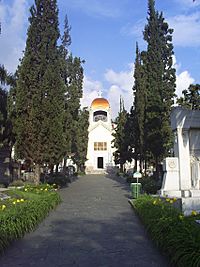San Pedro Cemetery Museum facts for kids
| Museo Cementerio San Pedro | |

Chapel of the San Pedro Cemetery Museum in Medellín, designed by Agustín Goovaerts
|
The San Pedro Cemetery Museum is a special place in Medellín, Colombia. It's both a cemetery and a museum! It was built way back in 1842. Later, in 1998, it became a museum. Then, in 1999, it was named a national monument of Colombia. This means it's a very important part of the city's history and culture. A group called the Foundation of San Pedro Cemetery takes care of it.
Many important people from Colombia's past are buried here. Their graves are like beautiful sculptures and buildings. But this place isn't just for remembering the past. It's also a cool spot for art and culture! You can find local and national art collections here. On nights when the moon is full, they even have concerts, shows, storytelling, theater, and dance performances. It's a unique way to experience history and art.
Contents
History of the San Pedro Cemetery Museum
The San Pedro Cemetery was started in 1842. At that time, Medellín was a small town called La Candelaria. It had about 9,000 people. It had only been the capital of Antioquia for 16 years. This was a time of big changes for the town. The population grew, and important businesses became stronger. There were also wars between political groups. People were exploring and settling new parts of western Colombia. Trade grew, industries began, and railroads were built. People also started using the Magdalena River for travel.
Why a New Cemetery Was Needed
On July 8, 1842, a man named Pedro Uribe Restrepo had an idea. He gathered important families from the town. They all agreed that Medellín needed a new cemetery. The only one they had, the San Lorenzo Cemetery, was too small. It couldn't serve all the families in Medellín anymore.
Founding and Early Names
The families decided to buy land in an area called El Llano. This area is now Bolivar Street. The land was quite large. On September 30, 1842, they officially bought the land. At first, the cemetery had different names. It was called the New Cemetery, of Individuals, or of San Vicente of Paul. In 1871, it finally got its current name: San Pedro Cemetery.
The "White City" Cemetery
Because rich and powerful families started the cemetery, it became known as the "cemetery of the rich." People also called it the "white city." This was because many of the tombs and statues were made of Carrara marble. Most of this beautiful white marble came all the way from Pietrasanta, Italy.
Growing and Changing Over Time
As Medellín grew, the cemetery also needed to expand. More land was bought around it. The first section built was the San Lorenzo gallery. This was on the southwest side of the main courtyard. This design was then used for other parts of the cemetery. In the 1920s, more improvements were made. A Belgian engineer and architect named Agustín Goovaerts designed the cemetery's chapel in 1925. He also created a monument for Camilo Restrepo in 1926.
Becoming a Museum and National Monument
Between 1996 and 1997, experts studied the cemetery. They found that some parts were getting old and damaged. They realized it needed protection. In 1997, they asked a government group called Colcultura to help. Colcultura is now part of the Ministry of Culture. They asked for the San Pedro Cemetery to be declared a national monument of Colombia. This request was approved, and it officially became a national monument in 1999. This helped protect its history and art for everyone to enjoy.
Famous People Buried Here
Many important people from Colombia's history are buried at the San Pedro Cemetery Museum. These individuals were leaders, artists, writers, and business owners. Their graves are often beautiful works of art.
Here are some of the famous people you can find here:
- Fidel Cano
- Mariano Ospina Rodríguez
- Pedro Nel Ospina
- Luciano Restrepo Escobar
- Pedro Justo Berrío
- Carlos Coriolano Amador
- José María Sierra
- Alejandro Ángel
- Efe Gómez
- Luis López de Mesa
- Félix de Bedout Moreno
- Manuel Uribe Ángel
- Pedro Estrado
- Luis Eduardo Yepes
- Jorge Isaacs
- Francisco Antonio Cano
- Marco Tobón Mejía
- Bernardo Vieco Ortiz
- Jorge Marín Vieco
- Pedro Nel Gómez
- Constantino Carvajal
- Rafael Sáenz
Images for kids
-
Mausoleum of Pedro Justo Berrío
-
Mausoleum of Jorge Isaacs
-
Mausoleum of Pedro Nel Ospina
-
Mausoleum of Carlos Eugenio Restrepo
-
Mausoleum of Francisco Antonio Zea
-
Mausoleum of Mariano Ospina Rodríguez
-
Mausoleum of Manuel Uribe Ángel
See also
 In Spanish: Cementerio Museo San Pedro para niños
In Spanish: Cementerio Museo San Pedro para niños

















